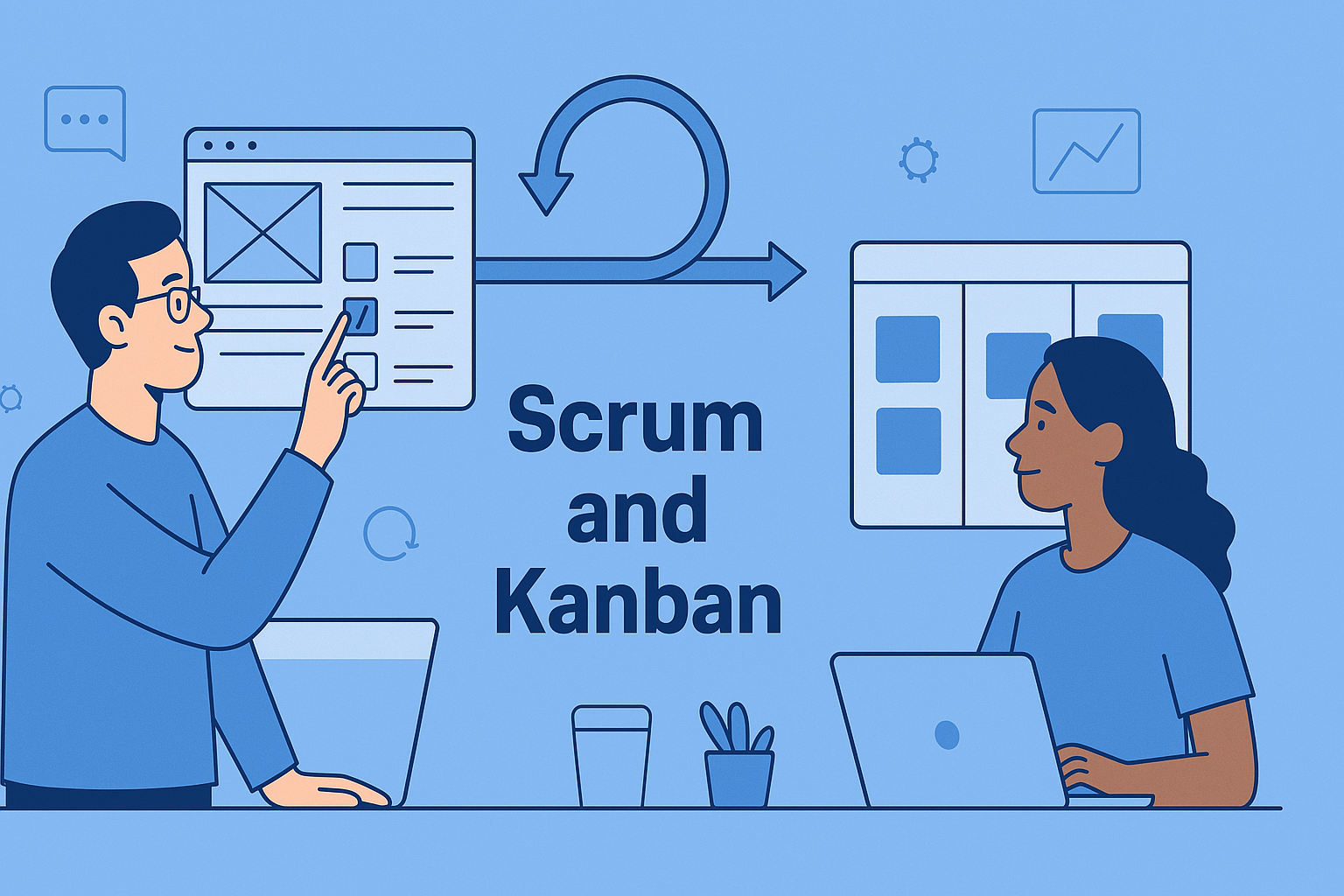· Software Development · 3 min read
The Ultimate Guide to Scrum and Kanban for Software Teams
Scrum and Kanban are two of the most popular Agile frameworks. Learn how they work, their differences, and how to choose the right fit for your development team.

Introduction – Why Agile Teams Choose Scrum or Kanban
Agile development offers flexibility, speed, and adaptability—but not all Agile teams are the same. Two of the most widely adopted Agile frameworks are Scrum and Kanban.
While both focus on iterative improvement, they differ in structure, roles, and how work is visualized and managed. Choosing the right one can significantly improve your team’s velocity, collaboration, and delivery.
This guide breaks down how Scrum and Kanban work, compares their strengths, and shows how to pick the best fit for your software team.
What is Scrum?
Scrum is a structured Agile framework that organizes work into time-boxed sprints, typically lasting 1–4 weeks.
Key Components of Scrum:
- Roles: Product Owner, Scrum Master, Development Team
- Artifacts: Product Backlog, Sprint Backlog, Increment
- Events: Sprint Planning, Daily Scrum, Sprint Review, Retrospective
Scrum is ideal for teams that value clear roles, regular planning, and structured delivery cycles.
Benefits of Scrum:
- High predictability through sprint planning
- Frequent feedback loops
- Clearly defined responsibilities and cadence
When to Use Scrum:
- When working on complex, evolving products
- When your team benefits from structured rituals
- When frequent stakeholder feedback is needed
What is Kanban?
Kanban is a visual workflow management method focused on continuous delivery rather than time-boxed iterations.
Key Principles of Kanban:
- Visualize work with columns (To Do, In Progress, Done, etc.)
- Limit work in progress (WIP) to reduce bottlenecks
- Focus on flow efficiency and process improvement
Kanban allows for more flexibility and adaptation in real time.
Benefits of Kanban:
- Easy to adopt and lightweight
- Optimized flow and reduced cycle time
- Immediate visibility into bottlenecks
When to Use Kanban:
- When your team handles ongoing or unstructured tasks
- When you need to start small and iterate fast
- When flexibility and real-time priorities are important
Scrum vs Kanban – Side-by-Side Comparison
| Feature | Scrum | Kanban |
|---|---|---|
| Iteration Style | Time-boxed sprints | Continuous flow |
| Roles Required | Yes (Scrum Master, PO, Dev Team) | No mandatory roles |
| Workflow Visualization | Sprint Backlog & Board | Task Board with WIP limits |
| Cadence | Fixed (1–4 weeks) | Flexible and ongoing |
| Best for | Structured, goal-driven teams | Reactive, fast-changing workloads |
| Focus | Predictability & feedback cycles | Flow efficiency & real-time agility |
How TaskFrame Supports Scrum and Kanban Workflows
Whether your team prefers Scrum or Kanban, TaskFrame adapts seamlessly to your workflow while adding a visual, wireframe-driven layer on top of traditional boards.
For Scrum Teams:
- Plan and organize sprints with clear task hierarchies
- Link tasks to specific wireframe elements for UI clarity
- Use real-time progress tracking to keep stakeholders aligned
- Customize properties for definition of done, estimation, priority
For Kanban Teams:
- Visualize work with flexible drag-and-drop boards
- Attach custom properties to any task using EAV model
- Optimize flow with work-in-progress indicators
- Collaborate visually via interactive wireframes that double as task hubs
In both cases, TaskFrame enables you to move beyond static tickets. Every task, whether in a sprint or Kanban column, is linked to a live wireframe or document, creating a fully connected planning environment.
Unlike tools like Jira, Trello, or Asana that separate planning from execution, TaskFrame combines docs, wireframes, and tasks—making it a powerful choice for Agile teams looking to scale with clarity.
Conclusion – Choose the Right Tool, Then Make It Work for You
Scrum and Kanban each offer distinct advantages:
- Scrum is great for structured, feature-driven work.
- Kanban offers continuous delivery and flow optimization.
- Some teams even combine them—running sprints with WIP limits, for example.
The method you choose matters. But the tools and habits you build around it matter even more.
Looking for a platform that supports both?
Try TaskFrame and experience Agile workflows enhanced by visual collaboration and smart task management.



